The City of Raleigh once again readies itself to toast the life of Rev. M.L. Latta, by investing in a ‘historic park‘ to celebrate the legacy of the man and his ‘university’. Recently inducted into the Raleigh Hall of Fame, the notorious con artist and grifter is surely chuckling in his grave as he continues to dupe well meaning victims a hundred years later.
We live in a time when there’s a new focus on spotlighting the achievements of people of color who have seemingly been ‘lost to history’. But Rev. M. L. Latta is not one of these heroes, nor has he ever been.
Latta’s ‘University’
A basic review of historical record and public accounts reveals a starkly different narrative –that of a prolific fraudster. He founded “Latta University” in Oberlin Village, an antebellum enclave founded by free blacks in West Raleigh. The primary goal of the university was enriching himself and his family. His scheme involved traveling across the North to solicit funds for his fictitious black university, employing a strategy modeled after Booker T. Washington that appealed to whites then and might, at face value, seem commendable today.
His neighbors in the Oberlin community were very outspoken when it came to denouncing Latta and his schemes. Residents frequently appear in the public record labeling Latta’s university as a scam.1“Suckers are Running Yet”
The Raleigh Times
Thu, Jan 18, 1912, Front page
“…[Oberlin residents] revealed the fact that Latta University exists in the Imagination of the “professor” and on the paper on which he writes his appeals for aid.”
Oberlin residents sounded the clarion call early, when Latta tried to exploit their name to bring credibility to his con. A year before the University’s founding, prominent families posted a signed public letter on the front page of Raleigh’s largest black newspaper, denouncing the man and saying they want nothing to do with him.2“A Card”
The Evening Visitor
Wed, Sep 9, 1891, Front page
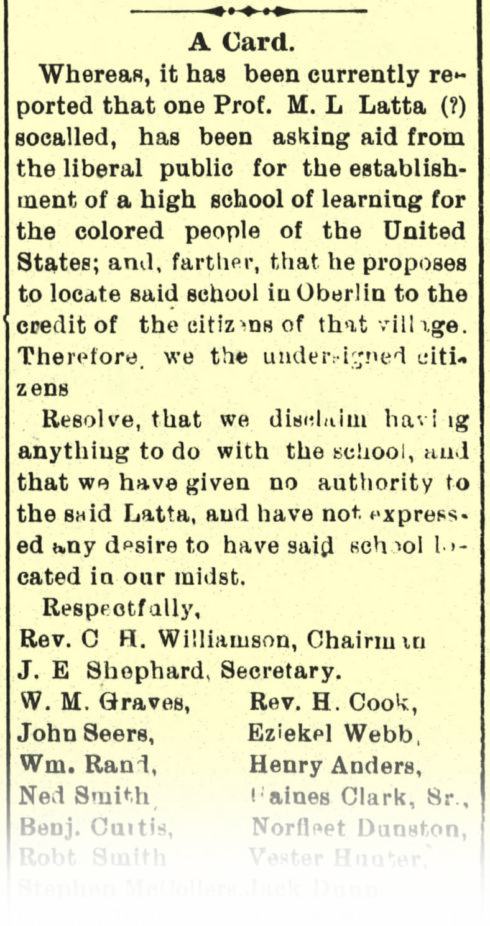
Let’s not overlook the importance of this, it was published a year before Latta incorporated the university as an actual school in North Carolina. Latta University was a ‘real’ school on paper, and it’s a valid question whether Rev. Latta actually tried to build a school in the early days, contemporaneous documents like this point to ‘no’.
Wake County’s own official history by Elizabeth Reid Murray characterizes him as “a real crook”3Wake: Capital County of North Carolina, vol. 2, and shares Oberlin interviews conducted by Shaw University Professor Wilmoth Carter:
“He started the place at a time when people were really giving to Negro education, so he raised a lot of money but it didn’t go into any school. Nobody cared enough about what he was doing to stop him, they just ignored him and his efforts.”
The full quote from Dr. Carter’s interview, which is available in her book The Urban Negro in the South is particularly damning4The Urban Negro in the South
Wilmoth Carter, 1961, page 118:
“Latta’s University was all bogus, it wasn’t even a good primary school. . . he only had two wooden buildings and they weren’t even good barns. The three or four students he had were members of his own family. He hardly had a fifth grade education himself.”
The Oberlin community saw right through his scheme and Latta publicly expressed a particular disdain for Oberlin residents, whom he described as “rude, obnoxious, and indolent,” or “officious and detestable.”5“Cannot Govern Themselves”
The News and Observer
Thu, Jan 25, 1900, Page 5.
It does seem Oberlin residents had a small victory in that the Reverend stopped using Oberlin’s name around this time, he even strikes it from his book completely, saying the university is located “West of Raleigh”.
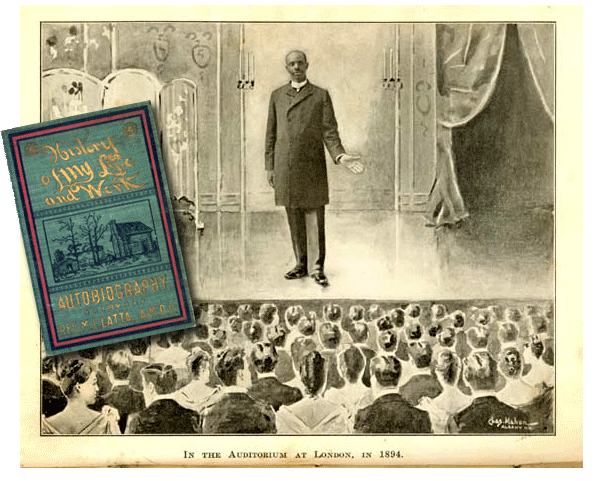
We wouldn’t be talking about Rev. Latta today had it not been for his autobiography “History of My Life and Work“, which he published in 1903. Morehead College history professor and former editor of the Journal of Negro History, Alton Hornsby, Jr. singled Latta out as an example of fraudulent black universities, and detailed how Latta used his autobiography as key tool in his scheme to swindle donors.6African Americans in the Post-Emancipation South, Alton Hornsby, Jr. Latta’s investment in his autobiography significantly amplified his fundraising efforts, giving him an aura of credibility.
It cannot be overstated: no one would even know M. L. Latta today had it not been for his book. (Read below: The Curse of the Singular Source)
In Historical Perspectives on the Education of Black Children, Harry Morgan labels Latta as an ‘outstanding example’ of fraud, and sheds light on the state of Latta’s operation at the time the book was published7Historical perspectives on the education of black children
Harry Morgan, 1995, page 80:
“[Latta] constructed what could only be described as a shack and went on a tour of the North to solicit funds for the “university”. At a time when Latta had one teacher and a few pupils, the founder and president published a 400 page book extolling the virtues of his institution as having 400 students and an elaborate campus.”
In his autobiography Latta writes that his University had 23 buildings and accommodated over 1400 students.8History of My Life and Work, page 55
Morgan London Latta, 1903 He writes about travels to Europe and consorting with Queen Victoria herself!9History of My Life and Work, page 283
Morgan London Latta, 1903 He later claims Her Majesty pledged to grant him an entire province if he would just ‘say the word’.10“Sued for Burning Six Hundred Lives”
The News and Observer
Wed, Apr 29, 1908, Page 5
The book has many photos of students, curiously: none showing more than 20. Even Latta’s own records do not account for the number of students he brags about in his book11Second Annual Catalogue of the Officers and Students of Latta University
Oberlin, North Carolina, 1893-1894. The book also has doctored photos, where he is cut out and placed in a fictional environment, like the one above which shows him speaking “in the Auditorium at London”. Latta frequently claimed the university was “one of the largest schools in the South in every respect”12History of My Life and Work, page 55
Morgan London Latta, 1903. In an attempt to support this in his book, he resorts to taking pictures of the same buildings from different angles. As an example, you can see the “Chapel”, “Young Men’s Dormitory” and “Young Ladies’ Dormitory” are all the same building from different angles. Which explains why the Young Men’s Dorm has no entrance.13History of My Life and Work, page 264
Morgan London Latta, 1903.
In 1916, the Phelps-Stokes fund sponsored a comprehensive study of American black universities conducted by the US Department of Education. The first chapter of this study highlights the issue of ‘larceny by false pretense,’ identifying Morgan Latta as the most “flagrant case” they have witnessed.14Negro Education: A study of the private and higher schools for thein the United States, Vol. 2
1916, Dept. of the Interior, Bureau of Education, Page 1 While Rev. Latta often claimed the university land was not in his name or for his benefit, their investigation uncovered that the land paid for by donations was actually in his wife Laura’s name:15Negro Education: A study of the private and higher schools for thein the United States, Vol. 2
1916, Dept. of the Interior, Bureau of Education, page 459
“…the property which has apparently been acquired by funds contributed for the supposed school is vested in the principal’s wife.”
This is corroborated in the Wake County Register of Deeds Property Index16Wake County Online Historic Property Index. They also go on to give another first hand account of what we’ve seen above:
“The property at the present time consists of 300 acres of valuable land on the outskirts of Raleigh a comfortable cottage used for the home of the principal and a dilapidated frame building formerly used for teaching a few pupils.”
It should be noted that the 1914 Sanborn fire insurance maps do not show 23 buildings, they only show two buildings on the survey.171914 Sanborn Fire Insurance Map, page 79
Raleigh, Wake County, North Carolina. Latta was in and out of court frequently fighting with insurers over what looks like insurance fraud. His home burned while it’s contents and furniture were conveniently moved out onto the lawn. 600 copies of his autobiography, which he was having difficulty selling, were burned in another empty building. In all, Latta’s insured properties were destroyed by five different fires and a cyclone. He had fire insurance, and the fire insurance property survey itself shows his autobiography to be false.18“He Had ‘Em All Insured”
The News and Observer
Wed, Apr 29, 1908, Page 5
The record is clear that Latta and his University were a scam, but less clear are how many scams Latta was running out of his university. The New York Age, widely considered one of the most prominent black newspapers of its time, has multiple articles condemning Latta University’s honorary degree abuse, whereby Latta conferred honorary doctorates –for a fee.19“Honorary Degree Abuse”
The New York Age
Thu, Mar 16, 1905, Page 2 The issue became so egregious that 14 years later, the state attempted to pass a law outlawing fraudulent degrees using Latta University as an example.20“Will Not Interfere With College Degrees”
The News and Observer
Tuesday, February 25, 1919, page 17 When the bill was narrowly defeated, the sponsor said that this “…leaves Latta University and its industrious president free to make B.A.’s, B.S.’s, LL.D.’s and D.D.’s of the newly made rich in the metropolis.”
Latta’s Corrosive Views
While some could ignore the man and his racket, many prominent blacks actively criticized and denounced Latta because of his beliefs and opinions21The Wilmington Messenger
Wilmington, North Carolina •
Wed, Jun 28, 1905, Page 3. In her book The Urban Negro of the South, Wilmoth Carter raises this issue in particular, going further to say Latta’s acceptance by whites and rejection by blacks was completely ‘understandable’ given his corrosive views22The Urban Negro in the South
Wilmoth Carter, 1961, page 118.
Our race is ignorant, as a rule, with few exceptions. The colored people, as a race, don’t seem to have much ambition about them. – M.L. Latta
The views Morgan Latta espoused publicly were that blacks were uncivilized, inferior and should be submissive and deferential to whites, whom he deemed ‘more capable men’23“Latta on Voting – Says Negro not Capable”
The Raleigh Times
Sat, Aug 25, 1900, Front page. He frequently said blacks ‘lacked ambition’, throughout his book he frequently refers to blacks as a ‘weak’ or ‘inferior’ race.24History of My Life and Work, page 20-21
Morgan London Latta, 1903 25History of My Life and Work, page 58
Morgan London Latta, 1903 26History of My Life and Work, page 105
Morgan London Latta, 1903 27History of My Life and Work, page 189
Morgan London Latta, 1903 28History of My Life and Work, page 237
Morgan London Latta, 1903 29History of My Life and Work, page 247
Morgan London Latta, 1903 30History of My Life and Work, page 278
Morgan London Latta, 1903 Latta’s views on lynching were particularly abhorrent and inexcusable.
The white man of the South is the best friend the negro has, if he behaves himself, and does not try to rule the country, because as I say [blacks] are not competent. – M. L. Latta
Latta not only felt that blacks should not vote or partake in politics, but he used his own community, that of Oberlin Village as a public example of why “blacks cannot govern themselves”.31“Cannot Govern Themselves”
The News and Observer
Thu, Jan 25, 1900, Page 5
For his part, Latta spoke frequently about the resistance he got from prominent black communities, and he often chalked this up to “ignorance, prejudice, and jealousy”32Oberlin Village Emerged during Reconstruction
The News and Observer
Sunday, August 08, 1948
Latta’s Fall
As of about 1907, the jig was up and the word was spreading. Fifteen years after black communities and newspapers sounded the alarm, the rest of the world seemed to come to the same conclusion. Latta’s family, operating the grift in the North were frequently getting apprehended33“Bogus Collector Loses Good Thing”
Altoona Times
Sat, Sep 25, 1909, Page 5, but instead of tossing in the towel, they came up with a plan.
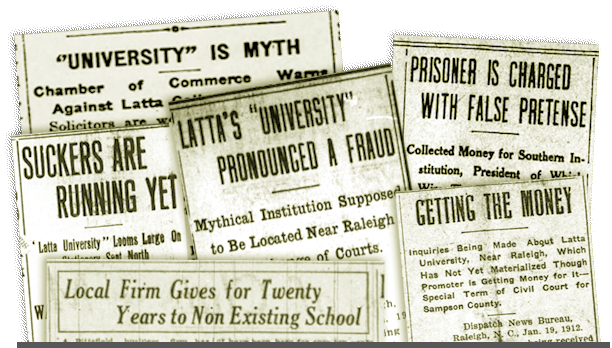
Latta’s brother-in-law John Bivans, would get arrested, then Latta would wire the police chief and say that Bivans had been requesting donations, pocketing them, and not sending the money back to the university. Latta would then ask for leniency, as Bivans was a cripple (mangled hand34The Raleigh Times
Thu, Dec 22, 1898, Front Page). The donations would get sent back to Raleigh, Bivans would get set free, sometimes with the mayor telling him never to return to their town. Today, we can see this plan play out across many local newspapers for years. They hit towns in Massachusetts35The North Adams Transcript
Fri, Feb 15, 1907, Page 8, Pennsylvania36“Prisoner is Charged with False Pretext”
Reading Times
Fri, Aug 11, 1911, Front Page 37“Collector Relieved of Checks and Book”
Reading Times
Sat, Aug 12, 1911, Page 5, New York38“Clancy Gets Another Solicitor Suspect”
Mount Vernon Argus
Sat, Mar 11, 1916, Front page, etc.
In 1916 Bivans was convicted in NY, even though Latta requested he be let go. It was then that Bivans came clean and said he was actually Latta’s brother-in-law and he was working under his direction. Regardless, Bivans was sent to the penitentiary on Blackwell’s Island.39“Fake Collector is Sent to Pen for Three Months”
Mount Vernon Argus
Monday, March 13, 1916, Front page
Around this time, the Charities Bureau of the Philadelphia Chamber of Commerce also investigated Latta University, pronounced it a fraud and sought to apprehend anyone claiming to represent it.40“University” Is A Myth”
The Philadelphia Inquirer
Sun, Sep 8, 1918, Page 22

One recurring theme is the toll Latta and his scams had on black communities. There’s evidence that his fundraising targeted upper class black communities in the North, who were motivated to contribute towards uplifting their Southern counterparts.41“Bogus Collector Loses Good Thing”
Altoona Times
Sat, Sep 25, 1909, Page 5.
Latta University officially closes on paper in 1922, as Latta sells off land to pay debts and he sells the deed to the school.42Book 408 Page 194
Wake County Records The remainder of the land is sold off in 1929, except for a small parcel that includes his house. The family is last listed in Oberlin on the 1930 census where Latta no longer lists himself as a professor, but a preacher. In 1933 his final parcel of land, the one containing his home is foreclosed and sold at auction to cover his debts.43Wake County Records
Book 596, Page 490
Now is usually the part of the story where I say that he skipped town and no one knows what happened to him. It’s a pretty odd mystery given the extent to which people are eager to commemorate the man. When dusting off this blog post, which had been sitting unpublished for years, the author decided to give it another go. I noticed that his final Wake County land records were all notarized in Philadelphia. A few hours later I found a small 87 year old obituary for the Reverend in the Philadelphia Inquirer44Philadelphia Inquirer, Apr 16, 1937, page 33.

Rev. Morgan London Latta died in Salem Massachusetts on April 13th 1937, his body was removed and interred at Eden Cemetery in Collingdale Pa in Lehman 113, lot 28. Notice that the obituary makes no mention of Latta University, nor does it say he was a professor.
The Curse of the Singular Source
You may be asking yourself how we got here, how on earth the City of Raleigh has for decades uncritically celebrated Reverend Latta and his colossal hoax as historical fact?
It may come as a surprise that Latta’s home received the designation of a Raleigh Historic Landmark and was listed in the National Register of Historic Places. This recognition was attributed to the ‘significant contributions’ he and the university purportedly made to our local history.
But this was all based solely on his autobiography, the tool he used to fleece donors.
The North Carolina Department of Cultural Resources submitted the paperwork nominating Latta’s home for the National Register of Historic Places in 2002. The State’s written historical support is sourced only from Latta’s autobiography, which is cited over 25 times in the 10 page submission, there is only one other source, an “unpublished student report”, let this sink in. 45Latta Home Submission
National Register of Historic Places Registration Form
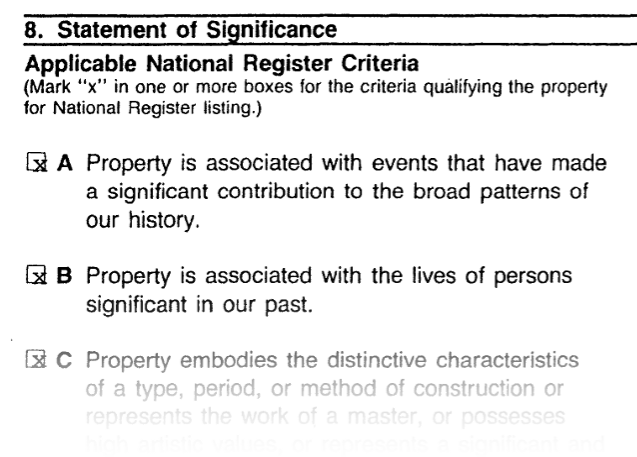
When the home burned to the ground in 2007, the above ‘research’ was used to convince the city to embarked on a costly archeological excavation46INTENSIVE CULTURAL RESOURCE INVESTIGATION: THE REVEREND M.L. LATTA HOUSE AND LATTA UNIVERSITY SITE WAKE COUNTY, NORTH CAROLINA
Raleigh Historic Districts Commission, 2009, the goal of which was to find any ‘significant archeological deposits’, which they defined as anything “related to the occupation of the site by the Reverend Latta, his family, and Latta University“, a pretty low bar when you’re digging up someone’s yard. The investigation did find deposits related to him: a horseshoe, some trash, etc. Enough to advise the city and the Raleigh Historic Districts Commission to redesignate the empty lot as a Raleigh Historic Landmark.
That 2010 Raleigh Historic Landmark designation submission again just lifts and regurgitates the 2002 National Register text, which as we’ve shown was just his autobiography taken as fact.47Raleigh City Ordinance No. 2010- 759
Historic Landmark Designation Application
“Suckers are Running Yet”
It’s unclear why Raleigh so uncritically celebrates this man, given the wealth of information about his views and life. At best, it’s a lazy interpretation of history that misses the mark, at worst, it pushes a false narrative, wastes tax payer money, and blatantly disregards the voices of black communities and newspapers that openly exposed Latta as a fraud.
Years ago, when he heard the city was planning the park to ‘celebrate the legacy’ of Rev. Latta the author sent the information above to the City, warning them that they need to stop using Latta’s book as their only source of information. During the park planning, the author and others raised these concerns in the public comment period, and those comments were removed from public view, “so as to be sensitive to living descendants”.48Information the author received from the City (email)
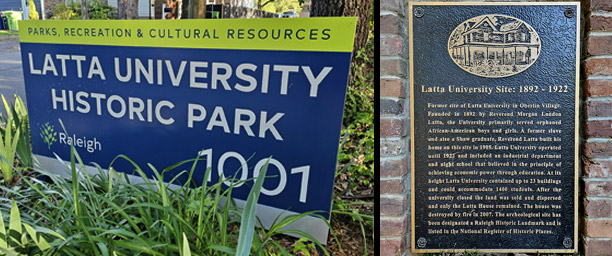
With facts in hand, Raleigh has decided again to embrace this false narrative, not only investing close to a million dollars into the park49Latta University Historic Park Master Plan
Priorities and Budget, page 135, but commemorating his dubious achievements with park signage, bronze historical markers, even Social Studies classroom content for schools, regurgitating the same falsehoods as indisputable facts.
Why? Some speculate that a requirement of the land being deeded to the city was that it be used as a memorial to Rev. Latta.50No Decision Made on Future of Latta House Site
WRAL News, 2007. Perhaps it’s too difficult to roll back decades of poor judgment and the city hopes that the truth will be lost.. drown out in their celebratory din. Whatever the case may be, the voices of the Oberlin community and those defrauded by Rev. Latta have ‘re-entered the chat’, and this public card will remain as their testament.
The reverend however, he would be happy to know that the City of Raleigh and his own descendants at the Latta House Foundation are proudly carrying on his colossal fabrication. That 100 years later, the university and life he worked so hard to concoct, which all came crashing down in his time, that every word he wrote was celebrated as undisputed fact. That suckers were still “running yet’.
Great stuff !